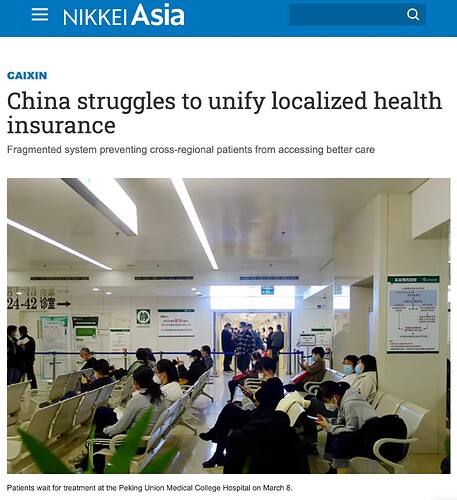-
中国的医疗保健系统受到不平等的困扰,大多数顶级医院都位于该国东部地区。这导致了医疗旅游,由于繁文缛节,使本地化的保险系统面临压力。
-
Lu Xiao就是一个例子,他不得不和他的母亲到400公里外的北京,为她的肝癌寻求更好的治疗。他的母亲不得不自掏腰包,因为她在山东的保险并不包括治疗费用。
-
中央政府正试图通过规范跨区域治疗的支付政策来解决这个问题,并推动一项由上级部门协调地方医疗保险计划的活动。然而,改革正在努力跟上老龄化社会的需求以及保险系统收入和支出之间的差距。
-
中国的国家医疗保险制度由国家医疗保障局负责监管,主要由市政府协调。
-
省级协调一直是政府改革议程上的重点,至少有8个省已经开始了这种类型的协调。
-
这种更高层次的协调将迫使当局遵循对病人更有利的地方卫生政策。
-
许多地方的医疗保险库房已经被大流行病和整体不断上涨的医疗费用耗尽。
-
统一的政策可能会加深该国目前因地区间医疗资源分配不均而造成的健康不平等。
-
对一个省采取统一的报销比例,将使较富裕地区的病人得到更多的报销。
-
中央政府正试图在保护跨地区病人的利益和防止地方政府面临更大压力之间保持平衡。
-
由于医院的不当行为,跨地区的病人比当地居民承担更多的费用。
-
由于个人缴费少,资金紧张,这给中国的基本医疗保险制度带来了额外的问题。
-
China’s health care system is plagued by inequity, with a majority of top-tier hospitals located in the eastern regions of the country. This has led to medical tourism, which is straining the localized insurance system due to red tape.
-
Lu Xiao is one example of an individual who had to travel 400km to Beijing with his mother in search of better care for her liver cancer. His mother had to pay out of pocket because her insurance from Shandong did not cover the treatment.
-
The central government is trying to address the problem by standardizing payment policies for cross-regional treatment and pushing forward with a campaign to have higher-level authorities coordinate local health insurance schemes. However, the reform is struggling to keep up with the needs of an aging society and the gap between insurance system income and outlays.
-
China’s state health insurance system is overseen by the National Healthcare Security Bureau and coordinated mainly by city governments.
-
Provincial-level coordination has been high on the government’s reform agenda with at least 8 provinces having started this type of coordination.
-
This higher-level coordination would force authorities to follow local health policies more favorable to patients.
-
Many local medical insurance coffers have been depleted by the pandemic and overall rising health care costs.
-
Unified policies could deepen the country’s current health inequities due to the uneven distribution of medical resources between regions.
-
Adopting a uniform reimbursement rate for a province would allow patients in wealthier areas to receive greater reimbursement.
-
The central government is trying to maintain a balance between protecting the interests of cross-regional patients and preventing greater pressure on local governments.
-
Cross-regional patients bear higher costs than local residents due to hospital malpractice.
-
This poses an additional problem to China’s basic health insurance system due to low personal contributions and stretched thin funds.
